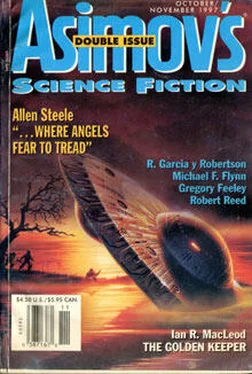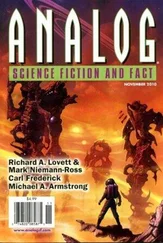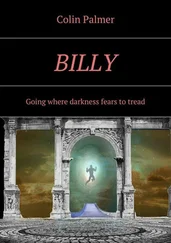Yet John and Emma Pannes wouldn’t perish in the coming inferno. In fact, they were very much alive, well, and living somewhere in the twenty-fourth century. The CRC advance team had quietly abducted them from their hotel suite at the Frankfurter Hof in the predawn hours of May 3, 1937, and delivered them safely to its safe house outside Frankfurt; by now they should have been picked up by the Miranda and transported to A.D. 2314. Franc hoped that the real John Pannes wouldn’t object too strongly to being kidnapped; given the alternative, though, he rather doubted that he would, once the facts were explained to him and his wife.
Now Franc was a sixty-year-old American businessman, and Lea was forty-five instead of twenty-nine. Nanoskin and vocodor implants had altered their appearance so convincingly that, two nights earlier, they were able to share a table in the salon with the Pannes’ old friend, Ernst Lehmann, the dirigible captain who was aboard the Hindenberg to observe Captain Pruss on his first transatlantic flight. They had dinner with Lehmann without the captain noticing any difference, yet they carefully remained aloof during most of the trip, preferring to remain in their cabin. The less interaction they had with the passengers and crew, the less chance of them inadvertently influencing history.
There had been a close moment yesterday, though, when they’d joined a tour of the ship.
The tour was necessary. John and Emma had toured the airship, so they had to follow the course of history. Yet, more importantly, it gave the researchers an opportunity to fulfill the primary objective of their mission: delivering an eyewitness account of the Hindenberg ’s last voyage, and documenting the reason why the LZ 129 had been destroyed. So while the passengers marched single-file along the keel catwalk running, gaping at the vast hydrogen cells within the giant duraluminum rings, Franc and Lea paused now and then to stick adhesive divots, each no larger than the rivets they resembled, to girders and conduits. They had artfully scattered the divots everywhere aboard the airship; the divots transmitted sights and sounds to the recorders concealed within Franc’s cigarette case and Lea’s makeup compact, both of which had evaded discovery by the Gestapo agents who inspected everything carried aboard the Hindenberg by its passengers before they left the Frankfurter Hof the morning of the flight. Of course, the Nazis had been searching for a bomb, not for surveillance equipment so microscopic that it could be hidden within commonplace items of the early twentieth century.
The incident occurred when the tour reached the airship’s stern, just below the place where the bomb was carefully sewn into the canvas liner beneath Cell No. 4. Kurt Ruediger, the ship’s doctor who was conducting the tour, had paused to point out the landing-gear well in the lower vertical stabilizer when they heard footfalls descending a ladder above them. A few seconds later, a rigger appeared from the darkness, stepping off the ladder to head forward toward the nose.
When he came into the half-light cast by the electric lamps strung along the catwalk, Franc and Lea recognized him at once: Eric Spehl, whom history would cast as the man who had planted the bomb that would destroy the Hindenberg. He didn’t look much like a saboteur, although he was within sight of the tiny package he had hidden in the gas cell while the ship was hangared at Friedrichshafen. Indeed, he seemed little more than an overworked rigger: a tall, blond man in drab cotton coveralls and rubber-soled shoes. As the passengers stepped aside to let him pass, though, Lea hesitated on the narrow catwalk. The necklace around her throat held a nanocam; this was her only chance to record Spehl’s image.
The heel of her left shoe caught on the aluminum-mesh floor, though, and she tripped and staggered backward, her hands blindly groping for the railing. The airship’s taut canvas skin lay only thirty feet below the catwalk; past that was a three hundred meter plummet into the frigid waters of the North Atlantic. Franc reached out to catch her, but Spehl was closer. He grabbed her by the shoulders and steadied her, then he smiled politely and said something about being careful, Fraulein. Then he turned and walked away.
A small occurrence, over and done within a few seconds, yet the significance of such incidents had long been a matter of debate within the Chronospace Research Center. Some researchers argued that world-lines were so rigid that even the slightest disturbance could have vast ramifications; look what had almost happened when the CRC placed someone in a parking lot behind a high fence near Dealey Plaza in Dallas on November 22, 1963. Others contended that chronospace was more flexible than anyone believed; minor accidents were allowable during expeditions because history was already in motion. It didn’t matter how many butterflies one crushed underfoot during the Pleistocene; the dinosaurs would die anyway.
Nonetheless, once Franc and Lea returned to their cabin, they had quietly fretted over whether the incident would cause a paradox. Yet history apparently hadn’t been disturbed. Monitoring the airship from their cabin the following morning, as the Hindenberg approached the American coast, they watched as Spehl walked down the keel catwalk, furtively looked either way, then climbed the ladder to Cell No. 4. The divot Franc placed at the bottom of the ladder couldn’t make him out in the visible spectrum, but his thermographic image showed him clinging to the ladder beneath the cell as he set the photographer’s timer that would send an electric current from two dry-cell batteries into a small phosphorous charge.
At 7:25 P.M. local, plus an indeterminate number of seconds, 203,760 cubic meters of hydrogen would be ignited. Thirty-seven seconds later, the Hindenberg would hit the ground as 241 tons of flaming mass.
Now the mighty airship was slowing down. Through the promenade windows, they saw the crackerbox shape of the hangar, the skeletal mooring mast surrounded by tiny figures in white caps. Franc tapped his glasses again: 19:17:31/-08.29(?). In a few seconds, the aft water ballast tanks would be released, the bow lines dropped.
It wasn’t the next eight minutes that bothered him, though; it was the thirty-seven-plus seconds which would follow the explosion. He and Lea had had little trouble getting aboard the Hindenberg. Now they had to see if they could get off again.
Thursday, May 5,1937: 7:21 P.M.
One of the most interesting things about the early twentieth century, Vasili Metz concluded, was the way Earth looked from space.
It wasn’t just the relative smallness of its cities, or the clarity of the skies above them, or the subtle differences of the coastlines. It was surprising to see New York City when its skyline was new and not half-submerged, but even that was to be expected. This was his third mission as the Oberon’s pilot, and he had become accustomed to such changes. What struck him as unreal was the emptiness of near-Earth space. No power-sats, no colonies, no shuttles. Chronos Station, the CRC’s low-orbit port where timeships began and ended their missions, was nowhere to be seen. There wasn’t even any space debris; the first satellite wouldn’t be launched for forty years, and another thirty years would pass before free-falling junk would pose a navigational hazard.
On the other hand, it would be another twelve years before anyone ever reported having seen a flying saucer. And it would remain that way if he had any say in the matter.
For the past three days, after a brief visit to Earth to drop off Lu and Oschner just outside Frankfurt, then a suborbital jaunt to deposit Tom Hoffman in New Jersey, Metz had held station in geosynchronous orbit above New Jersey. Except for when he monitored the Miranda’s departure, when it opened the wormhole that would send the support team, plus two nice people named John and Emma Pannes, back to Chronos Station, he had been almost alone.
Читать дальше












